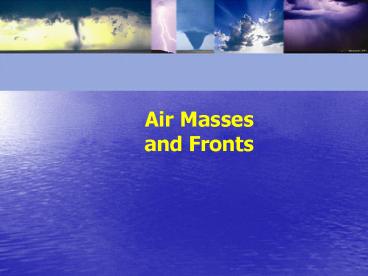Air Masses and Fronts - PowerPoint PPT Presentation
1 / 20
Title:
Air Masses and Fronts
Description:
Marked on a weather map as a red line with red semicircles pointing in the ... Marked on a weather map with a purple line containing alternating warm and cold ... – PowerPoint PPT presentation
Number of Views:318
Avg rating:3.0/5.0
Title: Air Masses and Fronts
1
Air Masses and Fronts
2
Air Masses
- An extremely large body of air whose properties
of temperature and moisture content are similar
in any horizontal direction - Usually cover hundreds of thousands of square
miles - Form when air stagnates for long periods of time
over a uniform surface - Over time, the air mass acquires the temperature
and moisture properties of the underlying surface
3
CLASSIFICATION
- FOUR BASIC CATEGORIES OF AIR MASSES
- POLAR - P
- ARCTIC - A
- TROPICAL - T
- EQUATORIAL - E
- TWO DESIGNATIONS OF SURFACE IN SOURCE REGION
- MARITIME - m
- . CONTINENTAL - c
4
(No Transcript)
5
Source Regions
- The birthplaces of air masses
- Must be dominated by light winds (or none at all)
- Must have an extensive, uniform surface
- Good regions are found
- Subtropics
- Interior of large continents
6
Air Mass Modification
- When an air mass moves away from its source
region, it will begin to change its temperature
and moisture properties to that of the new
underlying surface - If an air mass is heated from below, that will
lead to instability - If an air mass is cooled from below, stability
will increase
7
Maritime Tropical air mass
8
Fronts
- Temperature and moisture characteristics do not
often change gradually over distance - The transition zone between two different air
masses is called a front - So named because clashing air masses result in
inclement weather like 2 armies - Frontal zone the point where the front meets
the ground
9
Types of Fronts
- Fronts are classified by the temperature changes
that result after an air mass passes over a given
region - Cold front colder air will follow the fronts
passage - Warm front warmer air will follow the fronts
passage - Two other fronts exist as well stationary front
(no movement of air) and occluded front (cold air
forcing all the warmer air aloft)
10
(No Transcript)
11
Warm Front, moist air is slowly raised as it
flows over the cold air
12
Warm Front, moist air is forced upward by cold
front
13
Occluded Fronts
14
Cold Fronts
- Marked on weather maps as a blue line with blue
triangles pointing in the direction of movement - Temperature and humidity quickly drops after the
cold front passes - A decrease in pressure is also observed before
the front, and an increase afterward - Winds ahead of the front blow south/southwesterly
while winds behind the front blow
west/northwesterly - Lifting of warm air along the cold front is
pronounced - Precipitation tends to be showery due to
cumuliform clouds and limited to near the front
itself - Travel faster than any other kind of front
15
Warm Front
- Marked on a weather map as a red line with red
semicircles pointing in the direction of frontal
movement - Temperature and humidity increase after frontal
passage - Front is located in a region of lower pressure
than the surroundings - Winds ahead of the warm front are easterly, while
winds behind the front are southerly - Has a gentler slope than a cold front
- Warm air cant push the cool air in front of it
out of the way - The warm air rises over the cooler air
Overrunning - Clouds tend to be stratiform, and precipitation
is more moderate and steady - The height of the clouds decrease as the front
approaches
16
Occluded Fronts
- Marked on a weather map with a purple line
containing alternating warm and cold front
symbols (both in purple) on the same side of the
line indicating the movement of the front - Because warm fronts travel slower than cold
fronts, cold fronts can overtake warm fronts - When this happens, the warm air is forced aloft
as cold air surrounds the low pressure - A cold occlusion results if the cold air behind
the cold front is the coldest air on the map
(front will resemble a cold front at the surface) - A warm occlusion results if the cold air behind
the front is warmer than the cold air ahead of
the warm front (front will resemble a warm front
at the surface)
17
Stationary Fronts
- Marked with a line containing alternating warm
and cold front symbols (in their respective
colors) showing the way the warm air or cold air
would move if it could - Little or no movement of the frontal zone occurs
at the surface - The air aloft will usually be overrunning,
producing clouds - Weather conditions are usually similar to a warm
front, but milder - Extended periods of cloudiness and light
precipitation can develop along the cooler air
18
Dryline
- The dryline is a front separating cT air from mT
air - Found in the south-central US
- Temperature differences are usually small across
the dryline - Humidity contrasts are very significant
- Often provides a focus for thunderstorm
development over Texas, Oklahoma, and Kansas in
the spring
19
Cyclones Anticyclones
Air motion in cyclones and anticyclones.
20
Summary
- Air Masses are extremely large body of air whose
properties of temperature and moisture content
are similar in any horizontal direction. - Fronts are boundaries between Air Masses.
- Air that rises will cause insatiability in the
atmosphere.































